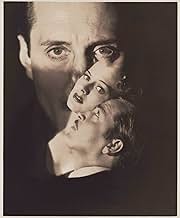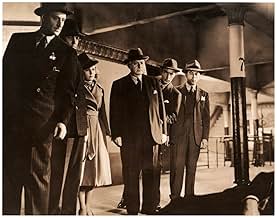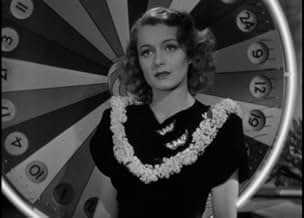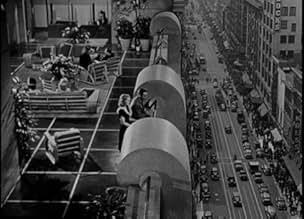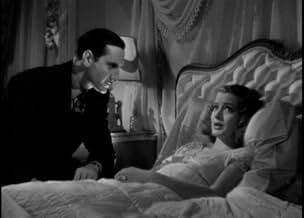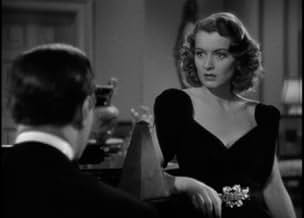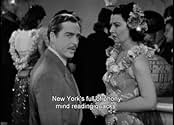Aggiungi una trama nella tua linguaA crazed physician marries a wealthy women and, with the help of his demented assistant, murders them for their money.A crazed physician marries a wealthy women and, with the help of his demented assistant, murders them for their money.A crazed physician marries a wealthy women and, with the help of his demented assistant, murders them for their money.
- Regia
- Sceneggiatura
- Star
Barbara Jo Allen
- Louise Watkins
- (as Barbara Allen [Vera Vague])
Bobby Barber
- Bald Man in Library
- (non citato nei titoli originali)
William 'Billy' Benedict
- Mickey Barnes - Copy Boy
- (non citato nei titoli originali)
George Chandler
- Elevator Operator
- (non citato nei titoli originali)
Edward Earle
- Librarian
- (non citato nei titoli originali)
Chuck Hamilton
- Police Officer at Train Station
- (non citato nei titoli originali)
Sam Harris
- Passerby
- (non citato nei titoli originali)
Harry Hayden
- Ticket Clerk
- (non citato nei titoli originali)
Douglas Kennedy
- Hotel Clerk
- (non citato nei titoli originali)
Settar Körmükçü
- Dr. David Profesor
- (non citato nei titoli originali)
John Laing
- Intern
- (non citato nei titoli originali)
Recensioni in evidenza
Basil Rathbone stars with Ellen Drew in The Mad Doctor from 1940.
Rathbone plays a psychiatrist, George Sebastien, who is a black widower, marrying women for their money and then killing them. The last time, the doctor in charge of his wife's case (Ralph Morgan) is suspicious, but Sebastien convinces his assistant (Martin Kosleck) that the old man is harmless. As usual, they pick up stakes, this time moving to New York City.
Sebastien becomes aware of a beautiful young woman, Linda Boothe (Drew) who is depressed and suicidal. He agrees to take her case.
Her boyfriend (John Howard) doesn't believe in psychiatry and wants to discredit him. As a reporter, he writes a series of negative articles.
The problem here is that Howard takes such an instant dislike to the doctor that it just comes off as jealousy. However, Sebastien does get to the reason for Linda's problems - her own father's suicide - and helps her.
Sebastien has actually fallen for Linda and believes he has been cured of his desire to kill. That apparently arose from his first wife cheating on him.
This is a very entertaining if strange film. One wonders about the relationship between Sebastien and his assistant, who is furious that Sebastien wants to marry Linda and stop killing.
Rathbone is terrific - romantic, charming, and evil. Drew is a lovely actress and ideal in her role. Martin Kosleck as the bizarre assistant is just right.
Recommended. Rathbone is always good.
Rathbone plays a psychiatrist, George Sebastien, who is a black widower, marrying women for their money and then killing them. The last time, the doctor in charge of his wife's case (Ralph Morgan) is suspicious, but Sebastien convinces his assistant (Martin Kosleck) that the old man is harmless. As usual, they pick up stakes, this time moving to New York City.
Sebastien becomes aware of a beautiful young woman, Linda Boothe (Drew) who is depressed and suicidal. He agrees to take her case.
Her boyfriend (John Howard) doesn't believe in psychiatry and wants to discredit him. As a reporter, he writes a series of negative articles.
The problem here is that Howard takes such an instant dislike to the doctor that it just comes off as jealousy. However, Sebastien does get to the reason for Linda's problems - her own father's suicide - and helps her.
Sebastien has actually fallen for Linda and believes he has been cured of his desire to kill. That apparently arose from his first wife cheating on him.
This is a very entertaining if strange film. One wonders about the relationship between Sebastien and his assistant, who is furious that Sebastien wants to marry Linda and stop killing.
Rathbone is terrific - romantic, charming, and evil. Drew is a lovely actress and ideal in her role. Martin Kosleck as the bizarre assistant is just right.
Recommended. Rathbone is always good.
I remember seeing THE MAD DOCTOR on TV back in the early 1960s and although I didn't see it again until the release of this Blu-Ray half a century later, parts of it, especially the ending, had remained with me. Why this film has not made its bow on home video until now is beyond me. It's an A Movie, as can be seen by the big budget, but with B Movie sensibilities regarding its use of character players outside of Rathbone and its overall Film Noir look which is due to cinematographer Ted Tetzlaff. Even the title sounds like a B Movie. However the strongest element in the whole mix is the screenplay. More about that later.
The plot concerns a suave Svengali-like psychiatrist played by Rathbone who marries wealthy women and then disposes of them. He meets a wealthy socialite who has suicidal tendencies (Ellen Drew) and plans to make her his next victim. Can her reporter boyfriend (John Howard), whom she has rejected, save her in time? Nothing out of the ordinary there. What IS different in THE MAD DOCTOR is the relationship between Rathbone and his constant companion played by Martin Kosleck. It is clearly a gay relationship in everything but name and how it got past the 1940 censors is a question worth asking.
The screenplay was originally written by top writers Ben Hecht & Charles MacArthur in the early 1930s and intended for John Barrymore (hence the Svengali angle). It was originally called "The Monster" and later "Destiny". That explains the quality dialogue which is one of the movie's highlights. When Barrymore bowed out, the script sat on the shelf for 5 years before Paramount used it. They had changes made by Howard W. Green who received sole screen credit. Although full of dark moments, there is a lightness of touch from director Tim Whelan which adds to the enjoyment. Kino deserves credit for resurrecting this forgotten gem. Once you see it, you'll wonder why it stayed hidden for so long...For more reviews visit The Capsule Critic.
The plot concerns a suave Svengali-like psychiatrist played by Rathbone who marries wealthy women and then disposes of them. He meets a wealthy socialite who has suicidal tendencies (Ellen Drew) and plans to make her his next victim. Can her reporter boyfriend (John Howard), whom she has rejected, save her in time? Nothing out of the ordinary there. What IS different in THE MAD DOCTOR is the relationship between Rathbone and his constant companion played by Martin Kosleck. It is clearly a gay relationship in everything but name and how it got past the 1940 censors is a question worth asking.
The screenplay was originally written by top writers Ben Hecht & Charles MacArthur in the early 1930s and intended for John Barrymore (hence the Svengali angle). It was originally called "The Monster" and later "Destiny". That explains the quality dialogue which is one of the movie's highlights. When Barrymore bowed out, the script sat on the shelf for 5 years before Paramount used it. They had changes made by Howard W. Green who received sole screen credit. Although full of dark moments, there is a lightness of touch from director Tim Whelan which adds to the enjoyment. Kino deserves credit for resurrecting this forgotten gem. Once you see it, you'll wonder why it stayed hidden for so long...For more reviews visit The Capsule Critic.
There is something really quite sinister to Basil Rathbone's title performance in this rather intimidating psychological thriller. We know from the outset that he has disposed of his wife "Ida" - ostensibly pneumonia - but the local physician "Dr. Downer" (Ralph Morgan) is suspicious. Shortly after cleaning up on the inheritance, he moves with his friend "Maurice" (Martin Kosleck) to start afresh. Now you don't have to be Einstein to recognise that these two men are more than just roomies, and that causes a bit of consternation when "Dr. Sebastian" finds new prey. This time, in the guise of the deeply troubled "Linda" (Ellen Drew). With a marriage and a trip to Quito on the cards, might history be about to repeat itself? Well, fortunately for "Linda" reporter "Sawyer" (John Howard) is also a bit suspicious of the man, and after a bit of investigation and a chat with "Downer", the two begin to piece together quite a different persona for Rathbone than the one he has been successful peddling thus far. Can they act in time to thwart his malevolent plan? Tim Whelan allows his star to exude menace here. The script is really only adequate, but the pace is good and the gradually accumulating sense of peril - and a wonderfully seedy contribution from the increasingly envious "Maurice" leads us towards a conclusion where nothing is predictable. Actually, on that front I was a little disappointed, but all in all, this is a dark and effective tale of manipulation that is well worth a watch.
Quite a few reviews here have mentioned the ' relationship ' between Basil Rathbone's character and Martin Kosleck's character as being coded homosexuals. I thoroughly endorse this as I watched this film quite by accident on YouTube and I was surprised to see just how intimate in speech and gesture this couple were. The fact that they were both killers and that women had been murdered for their rich lifestyle reminded me of other homosexual killers in both ' Rope ' and ' Compulsion. ' and how somehow they got certificates in the UK admitting children with adults to see them. In the UK the film was called ' A Date with Destiny ' and not the horror signifier of ' The Mad Doctor ' which would have called out for an H certificate for adults only. Rathbone believes he has been saved from evil by falling in love with his last prospective victim, and his male partner, quite rightly becomes as righteously cross as an abandoned ' wife ' or ' husband. ' A Queer film indeed which has not as far as I can tell by historians of Queer and Gay cinema been noticed. America has been fiercely aggressive towards positive gay endings, even to today so any representation on screen of a possible gay character or two in a partner relationship has had to follow the tropes of abandonment, death or imprisonment. For a gay audience these negatives had to be also positives simply because homosexuality was overtly or implicitly seen on the screen. I could take a swipe at a few recent examples but I will concentrate on this 1941 film. Tim Whelan directs it well in Film Noir mode, and there are outstanding shots of New York during this period. The editing excellent and the acting exceptionally good, Ellen Drew as the last potential victim is perfect, shading her role from black mood to light laughter with professional expertise. I must mention Barbara Jo Allen as a friend who has a lot of great lines, delivered to perfection. A definite Paramount Eve Arden, lightening the film whenever she is in a scene. To sum up a taut thriller with touches of horror this deserves in my opinion a ten. A vastly underrated film on all levels. One final observation: the BBFC was very reluctant to give out H certificates during WW2, so that may explain the change of the film's title.
Doctor Ralph Morgan calls at Basil Rathbone's home. His patient, Rathbone's wife, has died. Morgan is suspicious; she was recovering. He does nothing about it.
His suspicions are justified. Rathbone speaks with his manservant, Martin Kosleck, of how much he despised his rich wife and her stupid town, just like his other victims. They will return to New York, and he to his practice as a psychiatrist. There he is hired to deal with Ellen Drew, a depressed and suicidal socialite whose newspaper boyfriend, John Howard, has his suspicions. His investigations lead him to Morgan, even as Miss Drew marries Rathbone.
Rathbone offers his usual graceful performance as a man struggling with redemption. Most noteworthy of all, however, is Ellen Drew's performance as someone suicidal when we first meet her, to someone lighthearted after the ordinary pleasures of Coney Island. Alas, there is no sign of revival of her psychoses at the end, but in that era, endings had to be happy, even in a movie that focuses on Rathbone's attempts to deal with his own dark desires.
Hecht and MacArthur did uncredited work on the script, and they undoubtedly gave the producers what they asked for; neither was director Tim Whelan the man to stand up for a darker vision; he had returned to the US doing work on Korda's THE THIEF OF BAGDAD, and this was his first movie after that. It was no time to antagonize the brass at Paramount.
His suspicions are justified. Rathbone speaks with his manservant, Martin Kosleck, of how much he despised his rich wife and her stupid town, just like his other victims. They will return to New York, and he to his practice as a psychiatrist. There he is hired to deal with Ellen Drew, a depressed and suicidal socialite whose newspaper boyfriend, John Howard, has his suspicions. His investigations lead him to Morgan, even as Miss Drew marries Rathbone.
Rathbone offers his usual graceful performance as a man struggling with redemption. Most noteworthy of all, however, is Ellen Drew's performance as someone suicidal when we first meet her, to someone lighthearted after the ordinary pleasures of Coney Island. Alas, there is no sign of revival of her psychoses at the end, but in that era, endings had to be happy, even in a movie that focuses on Rathbone's attempts to deal with his own dark desires.
Hecht and MacArthur did uncredited work on the script, and they undoubtedly gave the producers what they asked for; neither was director Tim Whelan the man to stand up for a darker vision; he had returned to the US doing work on Korda's THE THIEF OF BAGDAD, and this was his first movie after that. It was no time to antagonize the brass at Paramount.
Lo sapevi?
- QuizOne of over 700 Paramount Productions, filmed between 1929 and 1949, which were sold to MCA/Universal in 1958 for television distribution, and have been owned and controlled by Universal ever since; its earliest documented telecast took place in Seattle Monday 11 May 1959 on KIRO (Channel 7).
- Citazioni
Maurice Gretz: You're like all the other clever ones, clever until they meet a woman, and then they suddenly become fools.
- ConnessioniReferenced in Svengoolie: Night Monster (2015)
- Colonne sonoreAloha 'Oe
Music by Queen Liliuokalani
I più visti
Accedi per valutare e creare un elenco di titoli salvati per ottenere consigli personalizzati
- How long is The Mad Doctor?Powered by Alexa
Dettagli
- Data di uscita
- Paese di origine
- Lingua
- Celebre anche come
- La cita fatal
- Luoghi delle riprese
- Azienda produttrice
- Vedi altri crediti dell’azienda su IMDbPro
- Tempo di esecuzione1 ora 30 minuti
- Colore
- Proporzioni
- 1.37 : 1
Contribuisci a questa pagina
Suggerisci una modifica o aggiungi i contenuti mancanti

Divario superiore
By what name was The Mad Doctor (1940) officially released in India in English?
Rispondi
